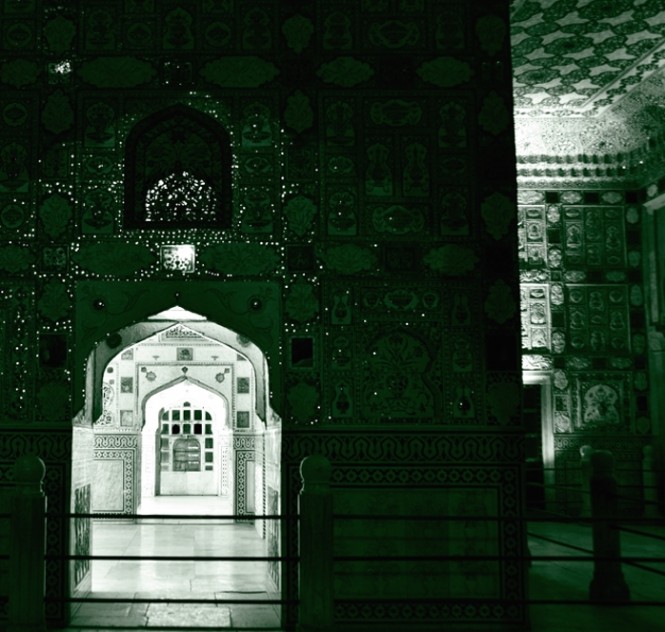
As dusk descended on the pink city, the yellow bulbs assisted by the moonlight came to the rescue of the Amber Fort, which otherwise slips into darkness. A night trip to the fort is four times costlier than the day trip. While an entry ticket during the day costs just INR 25 per Indian visitor, at night it becomes INR 100.
In 2013, Amber Fort (also known as Amer Fort), the hill fort in Jaipur, was included in the list of UNESCO World Heritage Sites for its elaborate planning, architecture, and art techniques borrowed from Maratha, Mughal, and Sultanate traditions of building forts. The Amber Palace represents an important stage of evolution of Rajput and Mughal style of buildings. Many unique features of the fort have already disappeared. For example, old exterior plaster has been replaced.
Raja Man Singh, one of the generals and Navratanas (Nine Gems) in the court of Emperor Akbar, laid the foundation of the fort in the 16th century. Thereafter, his successors added varied structures to the fort until 18th century. This state-protected monument is made of red sandstone and white marble. The rectangular fort site is four times longer than the width.

Although the Maota Lake in the foreground and the defensive walls of the hill fort were wrapped in darkness, well-informed police personnel recommended the attractions opened for visit from 7 to 10 pm. Soft lights made dark areas liveable for a while. The constables on duty and other staff were probably more in number than the visitors when I entered the fort. The parking lots were almost empty. But tourist guides were still there. All of them had a same sales pitch: “bina guide ke kuch bhi samjh nahi ayaga” (You’ll not understand anything without the help of the guides). They also flashed their government issued tourist guide licenses and quoted their fee (INR 150).

I managed to visit seven attractions of the fort that were open to public:
Sheesh Mahal
Sheesh Mahal (Glass Palace) drew maximum visitors. They probably find it the most perfect place for a memorable snapshot. It is said that the royal ladies were not allowed to sleep in open. So, they could not watch the night sky filled with twinkling stars. The king asked his architects to build a structure where ladies can enjoy the sky without breaking the social norms. The architects thought of a palace of glass that would reflect the sky.

Diwan-e-Aam
Pillared Diwan-e-Aam, the Hall of Public Audience, was well lit but visitors were not allowed to walk inside the hall. This is where the king interacted with the public. The pillars of the hall are crowned with elephant-shaped capitals and latticed galleries. One of the pillars bears an inscription.

Ganesh Pole
Ganesh Pole, a two-storey gateway, creates a clear boundary between public and private areas of the fort. The tall painted gateway features an image of Ganesh in the central arch space.

Jaleb Chowk
Jaleb Chowk, the main courtyard designed for public gatherings, was dark despite lighting. During the day time, the elephant rides conclude here.

Man Singh Palace
The Palace of Raja Man Singh was ready by the end of the 16th century after a long construction period spanning a quarter of a century. This erstwhile principal palace of the fort is now deserted. A baradari (pavillion) stands in the centre of the square within the palace. Most of the wall paintings and colourful tiles that used to adorn the palace are missing now.

Sukh Niwas
The Sukh Niwas (Pleasure Palace) was the special place where king used to spend leisure time with his queens and mistresses. The wooden doors are decorated with ivory inlay work. The palace consists of a big oblong hall, two rooms, and a veranda that overlooks a garden. The walls are embossed with plaster as per Mughal art principles.
The most interesting feature of the palace is its air cooling system. Highlights of the system include a water channel in each room, a marble cascade, walls of different heights built at different angles, and a pastel colour scheme. Collectively, these features cool the hot and dry desert air in the Pleasure Hall.

Charbagh
This rectangular garden is located opposite the Pleasure Hall. It follows the Mughal tradition of using short canals to create four sections in the green spaces.

A café, a souvenir shop and a bookstore were also open for visitors. However, all other shops were closed. The 700-foot-long tunnel was also closed.
For me, the trip was like reading a history book and deciphering the meaning in an open-air darkroom occupied by a few enthusiasts.





